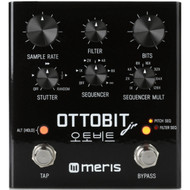Ottobit Jr. - Meris
by Coire Walker
Quarters were an asset in my adolescent years and during lunchtime at school, I would load up my pockets with a few handfuls of them and walk—pants sagging—several blocks to the convenience store. Beyond the junk food aisle, well past the rows of expired cans of tuna, and by the corner window, I would sink quarter after quarter into the arcade game, Narc. Trying to take out bad guys as the rogue narcotics officer cost me about fifty cents a minute—a lot of money in those days. My games didn't last long, but still, although I never possessed the funds (or the skill) to advance to the end stages and unseat the drug kingpin, using a rocket launcher to vaporize my enemies was cathartic. I am more well-adjusted these days, and my interests have shifted; however, when I pass those grimy, beat-up machines with their vibrant, pixelated displays bearing chicken-scratched graffiti, and see kids chuckling at the downsampled rumbles of rocket bombs, I get nostalgic. Some things never change.
The Ottobit Jr. by Meris is an auditory tribute to those years, an homage in stompbox form that offers a sample rate of 48Hz-48kHz, bit-crushing between 1-24 bits, with a low pass filter of 96Hz-24kHz and a sequencer with up to six customizable steps. There's tap-tempo, a configurable expression jack, and a "stutter," all of which make Ottobit Jr. incredibly versatile and accessible for live performance, recording, or just messing about. If you are an avid string player like myself, Ottobit Jr. might make you think less like a guitarist than you're used to, which I greatly appreciate. Think less Malmsteen and more Metroid.
The upper three knobs of Ottobit Jr.—Sample Rate, Filter, and Bits—are the primary articulative palette, operating in reverse conventionality. Fully clockwise for each provides a 48kHz sample rate, no filter sweep, and 24 bits, disengaging Ottobit's features. Proceed counterclockwise, and the samples and bits begin dropping off while the ladder-style filter takes effect. While feeding Ottobit a hastily-made loop of Chic's "Le Freak," I sat amidst a siren's song of industrial disco breakbeats and crushing arcade fuzz emanating from my confused amp.
Ottobit's lower three knobs—Stutter, Sequencer, and Sequencer Multiplier—allow you to take the crushed tones you've created and sequence, multiply, and endlessly manipulate them. Stutter is a riot, playing back slices of audio in rapid repeats of full, double, and half-speeds of the tapped tempo, creating that famous “stuck buffer” sound from the eighties, popularized by 80s stalwarts like Max Headroom. Dialed fully clockwise, the stutter randomizes while including a reverse variant, and you can also freeze the stutter by holding down the Tap footswitch. As "Le Freak" raged on under the influence of the stutter, I worked the dials like a mad DJ, unable to contain my laughter and knob tweaking.
The Sequencer and Multiplier knobs control the number of repeats and multiples of the original sequence speed. When the sequencer is active, the six operational knobs become fully customizable sequence steps for the three sequence modes—Sample rate, Filter, and Pitch. Holding the ALT button allows you to program the sequence steps, each taking the setting of its respective dial. For example, in Pitch Sequence mode, by setting each knob to gradually increase (dials at 1, 3, 5, 7, 9, 11), and with a bit of C minor noodling, I became shipwrecked, destroyed in a fog of gravelly bit-crushing sizzle. Lowering the bit and sample rates in Filter Sequence mode created everything from fuzzed-out sounds reminiscent of My Bloody Valentine to expansive chordal synthwave sounds like FM84 and The Midnight. A little exploration and I was creating cascading Mogwai-esque shoegaze electronica, with single-note lines becoming orchestral and mesmerizing. Entering Sample Rate mode let me relive my convenience store glory days, making those classic arcade game sounds that brought me back to my penchant for being annihilated by those digital drug dealers in Narc. Increasing the sequencer multiplier here and we ventured into friendlier video game turf, the sound of Mario shooting fireballs and laser beams, and entering warp zones with slower settings. Sequence speed can be changed via MIDI or the tap tempo footswitch, which is excellent for live performances and getting ideas out quickly.
You'll need an external footswitch to access Ottobit Jr.'s sixteen MIDI channels, preset banks, and save settings, and connecting an expression pedal will allow you to save/recall two presets. The expression feature is one of my favorite aspects of Ottobit Jr., allowing transition between two unique settings of all the knob values (yes, even the stutter!). For example, by tying the filter and bit depth to the expression pedal, you can create a wah effect while closed that blooms into bit-crushing fuzz when opened. Likewise, morphing between sequencer settings gets wild with the expression pedal as well. Super fun!
Meris has a unique black box here. Ottobit Jr. is a refreshing change of pace that makes me uncomfortable in all the right ways, a real inspiration I'm glad to have stumbled upon. Although I didn't pick up a musical instrument until well after my Narc playing days were over, if I had, I would have been stoked to have Ottobit Jr. along for the ride.
Price: $299


